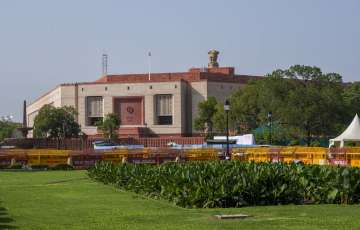New Parliament building inauguration: Prime Minister Narendra Modi inaugurated the new Parliament building on Sunday morning and installed the historic Sengol in a special enclosure on the right side of the Speaker's chair in the Lok Sabha chamber. The prime minister had laid the foundation stone of the new Parliament building on December 10, 2020. The present Parliament building was completed in 1927 and is now 96 years old.
Here are the 10 things that you should know about the new parliament building:
- The new building is triangular in shape to ensure optimum space utilisation, according to the Central Vista Redevelopment Project’s website. The four-storey building has a built-up area of 64,500 square metres. The building has three main gates -- Gyan Dwar, Shakti Dwar, and Karma Dwar. It will have separate entrances for VIPs, MPs, and visitors.
- The new Parliament building, constructed by Tata Projects Ltd, has a grand constitution hall to showcase India's democratic heritage, a lounge for MPs, a library, multiple committee rooms, dining areas and ample parking space. The new parliament is also ‘divyang-friendly’.
- The theme of the Lok Sabha and Rajya Sabha is based on India’s national bird (peacock) and national flower (lotus) respectively.
- The building can comfortably seat 888 members in the Lok Sabha chamber and 300 in the Rajya Sabha chamber. For a joint sitting of both Houses, 1,280 MPs can be accommodated in the Lok Sabha chamber.
- The new building has been designed in an ultra-modern fashion, geared with the latest communication technologies. It will also have larger committee rooms for enhanced efficiency.
- Each seat in the new Parliament House is equipped with a multimedia display in front, providing modern amenities to members of Parliament.
- The material used for the new building has been acquired from various parts of the country. The teakwood used in the building was sourced from Nagpur in Maharashtra, while the red and white sandstone was procured from Sarmathura in Rajasthan. Kesaria green stone, installed inside the Lok Sabha chamber, has been brought from Udaipur.
- The furniture was crafted in Mumbai and the materials used in sculpting the Ashoka Emblem were brought from Aurangabad and Jaipur. It also used manufactured sand or M-sand from Charkhi Dadri in Haryana for creating a concrete mix for construction activities.
- The 16-foot-tall bronze statue of Mahatma Gandhi, which has been the site of numerous protests and gatherings by MPs, will remain on the lawn between the old and new buildings.
- The new Parliament building is designed to withstand earthquakes. As Delhi is now in Zone 4, characterized by a higher earthquake risk, the new structure will be fortified to endure strong shocks in Zone 5.
Latest India News

